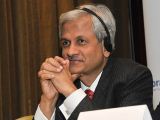An Interview with Dr. Sundeep Waslekar, President of the Strategic Foresight Group (SFG)
20 Dec 2013
The Strategic Foresight Group (SFG) is a think tank that helps conceptualize policies that decision makers can use to anticipate the future and influence its trajectory. However, policy making is often driven by short-term needs and requirements. How do you get decision and policy makers to pay more attention to long-term, macro-level risks and opportunities?
While policy making is a short-term process, it is often guided by long-term considerations and expectations. In fact, because policy makers tend to be occupied with immediate problems, that is precisely why they need advice from think tanks such as the SFG that can invest the time and energy that’s needed to look at macro-level problems. Over the past decade, for example, we have worked with policy makers from fifty countries in four continents and our reports have helped shape discussions at the United Nations, World Bank, Indian Parliament, European Parliament, British Parliament and other forums.
It must be said though that sometimes what appears to be a long-term issue can become a short-term one, which also validates the work we do. For example, in January 2008 SFG published a report (“external pageGlobal security and Economycall_made”) which focused on the medium-term risks of the global financial system collapsing in on itself. Sure enough, within a year the system was in serious trouble and more than a few practitioners were scrambling to read our analysis retroactively. So, what we and our colleagues do has utility in both directions – i.e., it helps policy makers look forward which can also mean looking at the here-and-now.
One important area of SFG’s research focuses on water security and trans-boundary water management. In particular, the research led to the development of the “Blue Peace Framework” (in partnership with the Governments of Switzerland and Sweden). What can you tell us about this initiative?
The seeming truth behind the Blue Peace Framework is that any two countries engaged in active water cooperation will not go to war with each other for any reason whatsoever. (This conclusion is based on a comparative analysis we recently conducted and which HRH Prince Hassan, who is the Chairman of the UN Secretary General’s Water Advisory Board, released last month. See “external pageWater Cooperation for a Secure Worldcall_made”.)
Now, since there is such a strong correlation between water, peace and security, SFG has developed a framework which redefines water so that it stops being a potential source of crisis and becomes an instrument of cooperation. This framework is known as the Blue Peace Framework and was introduced to the international community by the President of Switzerland in early 2011.
The Framework basically centers on 1) constructing regional cooperation institutions in ‘hydro-political regions’, 2) securing high-level political commitments to address water issues, and 3) using the cooperation mechanisms established by heads of government to negotiate tradeoffs between water and other public goods, such as development and security. We are currently using this framework, by the way, to restructure trans-boundary water relations in the external pageMiddle Eastcall_made, external pageNorthern Africacall_made and the external pageEastern Himalayascall_made.
What role does water play in the relations between India and Pakistan?
India and Pakistan have a water allocation agreement known as the Indus River Agreement of 1960. However, it hasn’t translated to substantial cooperation in the water sector. This lack of cooperation, as you can then imagine, has been at the center of the distrust that exists between the two countries. (Further information on our analysis of this problem can be found in our publication “external pageThe Indus Equationcall_made”.)
I would also like to draw your attention to water relations between India and Bangladesh, who share the important Ganges and Brahmaputra rivers. If the SFG Blue Peace formula for India and Bangladesh is finally implemented, we estimate it will improve the living conditions of up to 250 million people. (More information on our analysis and recommendations on this initiative can be found in our recently published report “external pageRivers of Peace - Restructuring India Bangladesh Relationscall_made”.)
SFG is also known for its ‘Cost of Conflict’ methodology. Can you elaborate?
The unique Cost of Conflict methodology developed by SFG measures the costs of conflict in any region of the world. It includes almost 100 parameters, including military, economic, political, diplomatic, psychological, environmental, cultural and social factors. (Within this context, SFG was the first organization to measure the opportunity external pageCost of Conflict in the Middle Eastcall_made for the two decades extending from 1990 to 2010.) As a tool, the Cost of Conflict methodology thus enables civil society and governments alike to reflect on the consequences of committing to a protracted conflict before they do so. In fact, it has primarily been used by those elements within a state that want peaceful relations with their rivals but need unequivocal data and analysis to support their positions.

